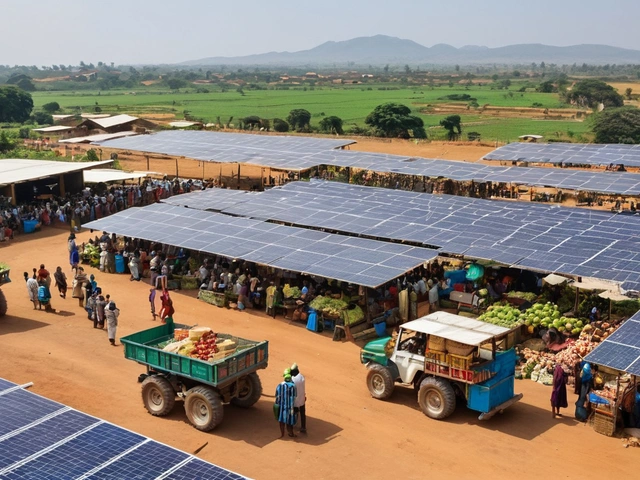Ethiopia's economy heavily depends on agriculture, employing a significant portion of the population.
Agriculture is the beating heart of Ethiopia, embodying tradition and pushing progress. Farmers work hard to produce diverse crops, making the sector a vital part of the country's economic fabric.
Coffee, often seen as Ethiopia's gift to the world, holds a special place. It stands as the nation's leading export, deeply woven into the culture and economy. Additionally, the livestock sector is a backbone, supporting families and driving local markets.
Challenges such as climate change and technological gaps exist, but efforts to introduce modern farming techniques are gaining momentum. Sustainable initiatives aim to secure a thriving future for Ethiopia's agriculture, balancing growth with environmental stewardship.
This journey through Ethiopia's largest industry reveals the intricate patterns of its agricultural landscape, shedding light on its pivotal role in the nation's present and future.
- The Role of Agriculture in Ethiopia’s Economy
- Major Agricultural Products and Exports
- Technological Advancements and Challenges
- Future Prospects and Sustainability
The Role of Agriculture in Ethiopia’s Economy
Ethiopia’s agriculture sector is undeniably the backbone of its economy, and it has been for centuries. This sector employs about 70% of the population, making it the primary source of livelihood for the majority of Ethiopians. The highlands and fertile valleys offer a conducive environment for various types of farming, which is crucial for food security and economic stability.
The nation’s diverse climate zones allow for the growth of a wide range of crops. From coffee, which is the country's leading export, to cereals, pulses, oilseeds, and more, agricultural products are top contributors to Ethiopia’s GDP. Ethiopia’s coffee is renowned globally, not just for its robust flavor but also because it is believed to be the birthplace of coffee. The coffee sector alone supports about 15 million people in the country, according to a report by the Ethiopian Coffee and Tea Authority.
Another significant aspect of Ethiopia’s agriculture is livestock. Ethiopia has the largest livestock population in Africa, which plays a crucial role in the rural economy, providing meat, milk, hides, and draught power. The livestock sector contributes around 15-17% to the GDP and creates substantial employment opportunities.
Despite these strengths, the agriculture sector faces numerous challenges. Issues such as land degradation, climate change, and lack of modern farming equipment hinder productivity. Most farming is still done using traditional methods, which makes it labor-intensive and less efficient. However, there have been ongoing initiatives to modernize agricultural practices. The government, with support from international organizations, is pushing for the adoption of modern farming techniques and technology.
Informative campaigns are being conducted to educate farmers on effective farming methods, proper irrigation techniques, and the benefits of crop rotation. This gradual shift towards modernization aims to increase yield and secure food supply, ultimately boosting the economy.
"Agriculture is our wisest pursuit because it will in the end contribute most to real wealth, good morals, and happiness." – Thomas Jefferson
Investments in infrastructure have also significantly contributed to the growth of the agriculture industry. Improvements in road networks, storage facilities, and market access have enabled farmers to sell their products more efficiently. The introduction of agricultural research centers scattered across different regions of the country has also played a role in disseminating knowledge and improving crop varieties to withstand local climate conditions.
Moreover, the government has been encouraging public-private partnerships to foster innovation and efficiency in agriculture. Programs like the Agricultural Transformation Agency (ATA) are focusing on key areas such as improving soil health, enhancing irrigation systems, and ensuring access to quality seeds.
What makes Ethiopia’s agriculture special are the centuries-old farming traditions combined with new opportunities for innovation. As Ethiopia navigates the complexities of modernization, the agriculture sector stands resilient, embodying the spirit and potential of the nation. By addressing current issues and capitalizing on its strengths, Ethiopia’s agricultural industry holds a promising future, positioning itself as a pivotal force in the country’s economic growth.

Major Agricultural Products and Exports
When it comes to Ethiopia's agricultural diversity, the country stands out with a range of products that fuel both domestic needs and export markets. One of the most celebrated exports is coffee. Often called the birthplace of coffee, Ethiopia produces some of the world’s finest beans. The coffee industry not only supports millions of smallholder farmers but also forms a significant part of the national identity.
Coffee isn't the only hero in Ethiopia's agricultural narrative. Grains such as teff, maize, and wheat also dominate the landscape. Teff, in particular, is unique to Ethiopia and is the main ingredient in the country's staple bread, injera. This tiny, nutritious grain has even caught the attention of international markets recently due to its high protein content and gluten-free nature.
Coffee: Ethiopia’s Jewel
Virtually every region in Ethiopia has its own coffee variety with unique flavors. Sidamo, Yirgacheffe, and Harrar are some names that coffee enthusiasts revere. Thanks to the perfect combination of altitude, climate, and fertile soil, these regions produce beans with distinct taste profiles. The growing international demand for Ethiopian coffee continues to boost its economy, further embedding coffee into the nation's economic foundation.
Livestock: The Backbone of Rural Life
Besides crop farming, livestock rearing plays a vital role in Ethiopia’s agriculture. Livestock contributes not just to food security but also to livelihoods, employing millions and supporting rural economies. The export of live animals, meat, and dairy products expands Ethiopia’s footprints into global markets. Livestock markets, vibrant and bustling, are a common sight, showcasing the abundance and variety of animals reared in the country.
“Ethiopia’s livestock sector is a jewel that has much potential yet to be fully realized,” says Dr. Fekadu Alemayehu, an agricultural economist.
A pulse of the nation, livestock markets depict cultural practices just as much as economic activity, creating a tapestry of commerce and tradition.
Other Key Agricultural Products
Ethiopia also excels in the production of various fruits and vegetables, which are making their way into new markets due to an increasing emphasis on quality and export readiness. Fruits like bananas, mangoes, and avocados have seen a surge in both local consumption and international demand. With such biodiversity, the country's agricultural sector is not only feeding its people but also creating considerable export revenue.
Spices, particularly korarima (Ethiopian cardamom) and long pepper, are traditional crops that continue to hold economic significance. Collectively, these products not only offer a snapshot into Ethiopia's rich agricultural tapestry but also highlight the sector’s immense potential for growth and diversification.

Technological Advancements and Challenges
Ethiopia's agricultural sector stands at a crossroads, where traditions meet modern technology. Over the past decade, there has been a substantial push to modernize farming practices, though it hasn’t always been smooth sailing. One key area of progress is the adoption of improved crop varieties designed to be more resilient to the changing climate—a critical move considering the country's reliance on rain-fed agriculture. Innovative irrigation systems, such as drip and sprinkler irrigation, have seen increased usage, helping to combat water scarcity issues that have historically plagued Ethiopian farmers.
Despite these advancements, challenges persist. One major issue is the limited access to modern farming equipment and machinery. Smallholder farmers, who make up a large part of the agricultural workforce, often rely on traditional tools, which can be less efficient and more labor-intensive. This gap in access to technology can be attributed to financial constraints and a lack of infrastructure to support widespread usage of modern equipment.
Another significant challenge is the lack of digital literacy among rural farmers. Technological adoption is not just about having the right tools but also knowing how to use them effectively. Educational programs aimed at increasing digital literacy and technical know-how have been implemented, but the reach and effectiveness of these programs can vary. Tech hubs and agri-tech startups in urban centers are working towards creating user-friendly apps and platforms to assist farmers, yet getting these to remote areas remains a logistical hurdle.
Extension services have been instrumental in bridging the knowledge gap. These services provide farmers with critical information on best practices, pest management, and efficient use of resources. However, the ratio of extension workers to farmers is quite low, limiting the impact of these programs. Agriculture remains the lifeblood of the Ethiopian economy, and bolstering the support systems around it is essential for sustained growth.
Government initiatives and international collaborations are also playing a vital role. Programs like the Agricultural Transformation Agency (ATA) are focused on improving productivity and market access. These initiatives aim to create an enabling environment for farmers to thrive, yet challenges like bureaucratic delays and resource allocation still need addressing.
There are also promising developments in the field of renewable energy for agricultural use. Solar-powered irrigation pumps and bioenergy projects are gaining traction, offering sustainable energy solutions that are both cost-effective and environmentally friendly. However, widespread adoption hinges on creating an affordable and accessible framework for all farmers. An integrated approach that combines technological advancements with education and sustainable practices is key to overcoming these challenges.

Future Prospects and Sustainability
The future of Ethiopia's agriculture hinges on addressing several key challenges while also harnessing emerging opportunities. Sustainable practices are front and center as the nation looks to balance growth with environmental care. In recent years, the government and various NGOs have ramped up efforts to support farmers with tools, training, and resources aimed at mindful cultivation.
One of the critical focuses is water management. Many areas in Ethiopia struggle with water scarcity, and innovative irrigation techniques are becoming essential. Programs like the Sustainable Land Management Program (SLMP) have already made significant strides in improving water use efficiency. This has not only bolstered crop yields but also improved the livelihoods of many farming communities.
Climate change remains a pressing concern, altering weather patterns and putting stress on traditional farming cycles. However, there's a movement toward climate-smart agriculture. Such practices involve crop diversification and the utilization of drought-resistant seeds. These innovations are showing promise in helping farmers adapt to changing climates. According to the World Bank, adopting climate-smart practices can potentially increase productivity by up to 25% in some regions.
Ethiopia's Minister of Agriculture once stated, "The resilience of our agricultural sector depends on how quickly and effectively we can innovate and adapt to the challenges posed by climate change."
Another promising avenue is the integration of digital technology in farming. Mobile apps provide farmers with real-time weather updates, market prices, and best practices for crop management. Digital platforms are also connecting farmers directly with buyers, cutting out middlemen and ensuring better prices for their produce. This tech leapfrogs traditional infrastructure, creating a more connected and efficient agricultural market.
Education and training are pivotal for sustainable growth. Various programs focus on educating farmers about sustainable practices. Training sessions on soil health management, organic farming, and responsible pesticide use are becoming increasingly common. Engaging the younger generation in agriculture through education can ensure the continuity and improvement of these practices.
Lastly, there's a growing emphasis on agroforestry and reforestation. Integrating trees into agricultural landscapes can improve soil quality, conserve water, and provide additional sources of income through fruit and wood products. The Green Legacy Initiative, for example, has planted billions of trees across Ethiopia, making a significant impact on both the environment and agriculture.
Ethiopia's agricultural future looks promising but demands continuous effort and adaptation. Through a blend of tradition and innovation, the nation can navigate challenges and seize opportunities, ensuring a sustainable and prosperous agricultural landscape for generations to come.

 Understanding the Major Health Concerns in Ethiopia
Understanding the Major Health Concerns in Ethiopia
 Is Ethiopia Still Considered a Third World Country in 2024?
Is Ethiopia Still Considered a Third World Country in 2024?
 Celebrating Ethiopia: A Look into Its Rich Heritage and Achievements
Celebrating Ethiopia: A Look into Its Rich Heritage and Achievements
 Top Profitable Businesses in Africa: Revealing the Best Money-Makers
Top Profitable Businesses in Africa: Revealing the Best Money-Makers
 Top Investment Opportunities in Ethiopia 2024
Top Investment Opportunities in Ethiopia 2024
RUBEN INGA NUÑEZ
September 4, 2024 AT 18:16Ethiopia’s agricultural sector is undeniably the backbone of its economy, yet many observers overlook the structural inefficiencies that cripple its potential. The reliance on rain‑fed farming creates a chronic vulnerability to climate variability, which the government has failed to address with sufficient investment in irrigation infrastructure. Smallholder farmers continue to use outdated tools, limiting yields despite the availability of improved seed varieties. Moreover, land tenure insecurity discourages long‑term investments, as tenants fear arbitrary redistribution. The export of coffee remains a lucrative avenue, but price volatility on the global market exposes producers to undue risk. While international NGOs pour funding into development projects, coordination among agencies is often chaotic, resulting in duplicated efforts. The Agricultural Transformation Agency has made commendable strides, yet its bureaucratic delays undermine rapid adoption of technology. Digital literacy among rural communities remains alarmingly low, hampering the effectiveness of mobile‑based advisory services. Water management initiatives, such as the Sustainable Land Management Program, are promising but lack scalable financing mechanisms. Livestock production contributes substantially to GDP, but unchecked expansion leads to overgrazing and soil erosion. The government’s emphasis on road construction improves market access, yet storage facilities remain insufficient, causing post‑harvest losses. Climate‑smart agriculture is frequently touted, but concrete policy frameworks are still in draft form. Without decisive policy reforms, the sector will continue to operate under a patchwork of half‑implemented programs. Investors should demand transparency and accountability from both state and private partners. In sum, Ethiopia possesses immense agricultural talent, but it is shackled by systemic neglect and fragmented implementation. A rigorous, data‑driven approach is essential if the nation hopes to convert its fertile lands into sustainable prosperity.
Michelle Warren
September 14, 2024 AT 16:16i cant even with this whole coffee hype-yeah, it's cool but there's way more to Ethiopia than beans. the article kinda drags and i feel like it missed the real hustle on the ground.
Christopher Boles
September 24, 2024 AT 14:16Ethiopia’s farms are truly the heart of the country. The coffee growers and teff farmers both keep families fed and proud. New irrigation projects are helping villages that used to dry out each season. When the government backs up training programs, yields can finally rise. It’s exciting to see tradition and technology working side by side.
Crystal Novotny
October 4, 2024 AT 12:16Many praise the coffee boom as pure progress but overlook the labor strain. The narrative often ignores the seasonal migration of workers seeking work. One could argue that true sustainability requires more than export numbers. Still the data shows mixed outcomes for smallholders.
Reagan Traphagen
October 14, 2024 AT 10:16The so‑called development aid pouring into Ethiopia is nothing but a strategic foothold for foreign powers. Every irrigation pump installed carries hidden tracking devices that monitor farmer movements. International NGOs disguise their geopolitical agenda behind glossy brochures about sustainability. The livestock subsidies are actually a front for meat export contracts that enrich multinational corporations. Climate‑smart agriculture sounds noble, yet it serves as a cover for data harvesting on land use patterns. Until the populace awakens to this manipulation, true independence will remain a myth.
mark sweeney
October 24, 2024 AT 08:16i dont think all this hype about 'climate‑smart' is legit it's just buzzword marketing. sure, some farmers get new seeds but the majority still cant afford a decent hoe. the gov't says they invest billions yet you still see rusted tools in the fields. maybe we need to look at root causes like land grabs rather than cute apps. also, the coffee story? overblown, many beans never make it past the local market.
randy mcgrath
November 3, 2024 AT 05:16Agriculture, at its core, reflects a dialogue between humans and the earth. When Ethiopian farmers tend their plots, they practice a quiet philosophy of patience and resilience. Modern tools can enhance this relationship, but they must respect the rhythms that have sustained generations. A balanced approach honors both innovation and the inherited wisdom of the land. In that sense, progress becomes a shared meditation rather than a forced march.
Frankie Mobley
November 13, 2024 AT 03:16If you're curious about how Ethiopian coffee gets its distinct flavor, it's all about altitude and traditional processing methods. Small cooperatives often hand‑pick the cherries and dry them on raised beds, preserving natural sugars. For teff, the key is rotating fields to maintain soil fertility, a practice passed down for centuries. Sharing these details helps outsiders appreciate the cultural depth behind each cup and loaf.
ashli john
November 23, 2024 AT 01:16What really draws me to Ethiopia’s farms is the community spirit they show every harvest I love how families gather around the field and celebrate the bounty It’s amazing to see kids learning the ropes early on and how that builds confidence I wonder how we can support more youth programs that teach sustainable techniques together we can keep the tradition thriving
Kim Chase
December 2, 2024 AT 23:16Hey folks, just wanted to point out that while tech helps, we shouldn't forget the value of old‑school knowledge too. Many elders know exactly when to sow based on cloud patterns-a skill that apps can't fully replace. Maybe pairing their advice with GPS data could give a more complete picture. Let’s keep the conversation inclusive and respect both sides of the spectrum.
David Werner
December 12, 2024 AT 21:16The shadows behind Ethiopia’s new solar‑powered pumps whisper of a surveillance network unseen. Each panel, while shining bright, could be a beacon for distant satellites tracking fertilizer usage. If the state can watch water flow, imagine the power they wield over food distribution. The drama unfolds in villages where lights flicker, and rumors spread faster than the wind. This is not just agriculture; it’s a silent war for control over the very breath of the nation.
Paul KEIL
December 22, 2024 AT 19:16From a systems‑theory perspective, Ethiopia’s agronomic ecosystem exhibits high entropy due to fragmented input supply chains. Leveraging integrated pest management protocols could mitigate variance in yield outputs. Moreover, capital‑intensive mechanization must be aligned with scalable micro‑finance models to achieve sustainable adoption. The current policy matrix lacks coherent KPI alignment, resulting in suboptimal ROI for stakeholders. A paradigm shift toward data‑driven analytics is imperative for sectoral optimization.
Horace Wormely
January 1, 2025 AT 17:16It's "their" not "there's" when referring to the farmers' challenges.